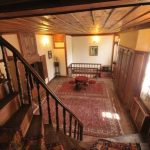The “house”, which is the first and most special product of the relationship between space and human, has long gone beyond the boundaries of the field of architecture and has been adopted as an indicator of a wide field of disciplines. The “Turkish house”, on the other hand, has been the subject of research since the 20th century, despite its diversity, covering a wide historical and geographical area.

Turkish housing tradition has preserved its basic layout and originality in the placement of the elements for centuries. At the origin of the chamber space lies the existence of nomadic traditions; life and form are intertwined. Enriched by the overlapping of nomadic pragmatism and Islamic abstraction, this residence also reflects the local characteristics of Anatolian-Turkish society. With the consolidation of Ottoman rule in the second half of the 16th century, it reached its zenith and found its original expression in the “living house”. Although the Turkish house has been described in travel books, engravings and pictures for five hundred years, the limited life of the building materials, especially wood, did not leave enough data to examine this architecture in all its details.










































